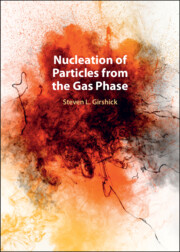Book contents
- Nucleation of Particles from the Gas Phase
- Reviews
- Nucleation of Particles from the Gas Phase
- Copyright page
- Dedication
- Contents
- Preface
- Symbols
- 1 Introduction
- 2 Single-Component Homogeneous Nucleation from a Supersaturated Vapor
- 3 Classical Nucleation Theory
- 4 Classical Theory of Multicomponent Nucleation
- 5 Classical Theory of Ion-Induced Nucleation
- 6 Atomistic Approaches to Homogeneous Nucleation
- 7 Transient Nucleation
- 8 Chemical Nucleation
- 9 Nucleation in Plasmas
- References
- Index
2 - Single-Component Homogeneous Nucleation from a Supersaturated Vapor
Published online by Cambridge University Press: 30 May 2024
- Nucleation of Particles from the Gas Phase
- Reviews
- Nucleation of Particles from the Gas Phase
- Copyright page
- Dedication
- Contents
- Preface
- Symbols
- 1 Introduction
- 2 Single-Component Homogeneous Nucleation from a Supersaturated Vapor
- 3 Classical Nucleation Theory
- 4 Classical Theory of Multicomponent Nucleation
- 5 Classical Theory of Ion-Induced Nucleation
- 6 Atomistic Approaches to Homogeneous Nucleation
- 7 Transient Nucleation
- 8 Chemical Nucleation
- 9 Nucleation in Plasmas
- References
- Index
Summary
Clusters can form and grow from a supersaturated vapor by successive reactions in which molecules (or “monomers”) of the vapor collide with the cluster and stick. In general, these reactions are reversible. The net forward rate of each of these reactions is termed the “nucleation current” of clusters of the size formed by the reaction. If a steady-state cluster size distribution exists, then the nucleation currents for clusters of all sizes are identical and can be equated to the steady-state (or “stationary”) nucleation rate. In that case, one can derive a closed-form expression for the nucleation rate in terms of a summation over clusters of all sizes up to some arbitrarily large size. The key terms in this summation are the forward rate constants and the Gibbs free energies of cluster formation from the monomer vapor. Evaluating the summation requires size-dependent values of these terms. For saturation ratios that lie within the condensation–evaporation regime, the free energy of cluster formation has a maximum at the critical cluster size. The nucleation theorem relates this size to the dependence of the nucleation rate on saturation ratio.
Keywords
- Type
- Chapter
- Information
- Nucleation of Particles from the Gas Phase , pp. 14 - 31Publisher: Cambridge University PressPrint publication year: 2024

